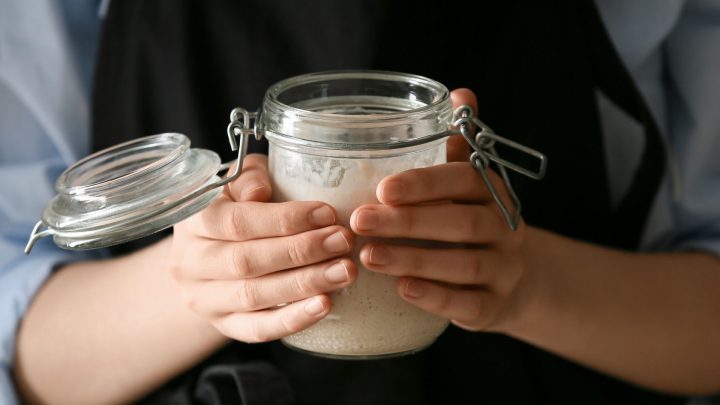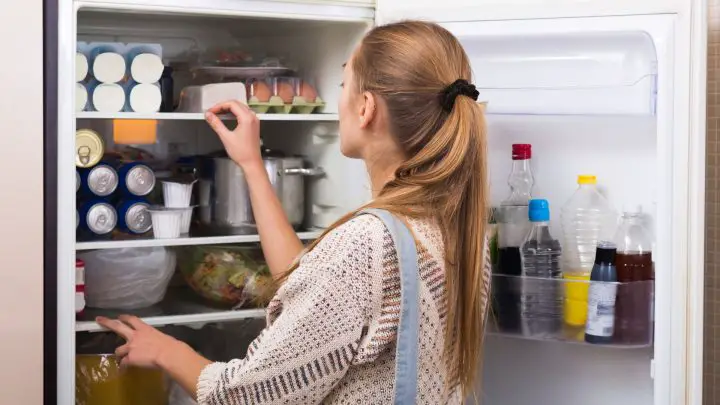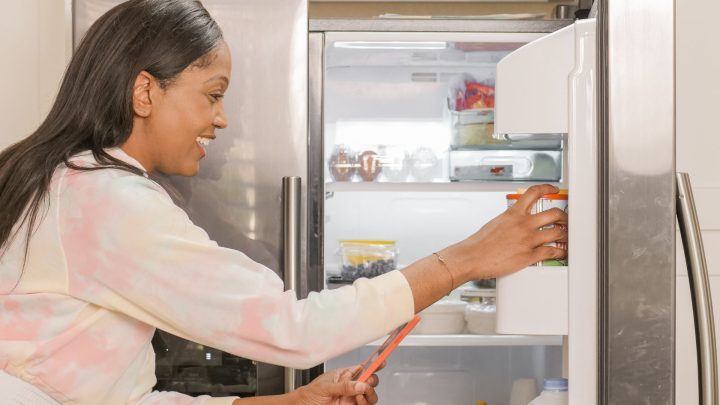If you’re a sourdough enthusiast, you know the joy of nurturing a living, bubbling sourdough starter. But what if you suddenly find yourself in the midst of a baking urge and your starter is chilling in the refrigerator? Don’t worry, because the answer is yes – you can indeed use your sourdough starter straight from the fridge! And here’s how!

Table of Contents
- How Do You Use Sourdough Starter That Has Been Refrigerated?
- Can I Use Sourdough Discard Straight From The Fridge?
- How Long Should Sourdough Be Out Of The Fridge Before Baking?
- What Happens If You Don’t Feed Your Sourdough Starter In The Fridge?
- How to Prevent a Starter From Dying In The Fridge?
- So Can I Use My Sourdough Starter From The Fridge?
- FAQs
How Do You Use Sourdough Starter That Has Been Refrigerated?
When using a sourdough starter that has been refrigerated, there are a few steps to follow.
- First, take the starter out of the fridge and allow it to come to room temperature. This usually takes a couple of hours.
- Once it has warmed up, discard a portion of the starter to maintain a manageable quantity and reduce any potential off-flavors.
- Then, feed the remaining starter with equal parts of flour and water, stirring well to incorporate the fresh ingredients.
- Let the starter sit at room temperature for a few hours or until it becomes active, showing signs of fermentation such as bubbles and an increase in volume. Once the starter is lively and vigorous, it’s ready to be used in your favorite sourdough recipes, adding that signature tang and complexity to your baked goods.
Sourdough Starter Refrigerated For 2 Days or Less
If your sourdough starter has been refrigerated for 2 days or less, it is still relatively fresh and can be used without much reactivation.
Simply take the starter out of the fridge and let it come to room temperature, which usually takes a couple of hours.
The moment it has warmed up, you can use it directly in your recipes without discarding or feeding it. This is because the starter has had less time to lose its activity and will still contain enough viable yeast and bacteria to contribute to the fermentation process. Incorporate the refrigerated starter into your bread dough or other sourdough recipes as you would with an active starter, and enjoy the distinct flavor and texture that sourdough brings to your creations.
Sourdough Starter In The Fridge For a Week or More
If your sourdough starter has been in the fridge for a week or more, it will require some reactivation before it can be used in recipes. Start by taking the starter out of the fridge and allowing it to come to room temperature, which might take a couple of hours.
Once it has warmed up, discard a portion of the starter to reduce the quantity and refresh it. Feed the remaining starter with equal parts of flour and water, mixing well to incorporate the fresh ingredients. Let the starter sit at room temperature for a few hours or until it becomes active, showing signs of fermentation such as bubbles and an increase in volume.
This refeeding process helps revive the dormant microorganisms in the starter and replenishes its food supply. Once the starter is lively and active again, you can proceed to use it in your sourdough recipes, ensuring that your baked goods possess the desired flavor and texture that only a well-maintained starter can provide.
Can I Use Sourdough Discard Straight From The Fridge?
Yes, you can use sourdough discard straight from the fridge in certain recipes.
Sourdough discard refers to the portion of sourdough starter that is removed during the feeding process. When stored in the refrigerator, the discard can develop a tangy flavor and become less active. While it may not have the same leavening power as a freshly fed starter, it can still be incorporated into various recipes.
Sourdough discard is commonly used in recipes like pancakes, waffles, crackers, and some types of bread. Its acidic nature can contribute to a unique flavor profile in these dishes.
However, keep in mind that the discard’s reduced activity may affect the final texture and rise of your baked goods, so it’s essential to consider the specific recipe and make any necessary adjustments accordingly.

How Long Should Sourdough Be Out Of The Fridge Before Baking?
The ideal time for sourdough to be out of the fridge before baking can vary depending on several factors, including the temperature of your kitchen and the specific recipe you’re using. However, a general guideline is to allow the sourdough to come to room temperature and become active again. This usually takes anywhere from 1 to 4 hours.
If you’re using sourdough starter directly from the fridge to make bread, it’s a good idea to give it some time to wake up and regain its activity. Remove the starter from the fridge and let it sit at room temperature for about 1 to 2 hours, or until it starts showing signs of activity. You can check for signs of activity by looking for bubbles forming on the surface or performing the float test, where you drop a small amount of the starter into a bowl of water and see if it floats.
For recipes that call for using sourdough discard, you don’t necessarily need to wait for the discard to become active again. Since the discard is usually not the primary leavening agent in those recipes, it can be used straight from the fridge.
Remember, these are general guidelines, and it’s important to adjust the timing based on the specific conditions in your kitchen and the behavior of your sourdough starter. Observing the signs of activity and adjusting the fermentation time accordingly will help you achieve the best results in your sourdough baking.
What Happens If You Don’t Feed Your Sourdough Starter In The Fridge?
If you don’t feed your sourdough starter while it’s in the fridge for an extended period, several things can happen:
- Reduced Activity: The yeast and bacteria in the sourdough starter rely on a regular supply of food (flour and water) to stay active and healthy. Without regular feeding, their activity gradually decreases, and the starter becomes less lively and responsive.
- Acid Accumulation: As the yeast and bacteria consume the available nutrients in the starter, they produce acids. Over time, if the starter isn’t fed, the acid levels can increase, making the starter more acidic. This can affect the flavor profile and potentially hinder the starter’s leavening ability.
- Separation: If the starter isn’t fed, you may notice a separation of liquid on top of the starter. This is known as “hooch” and is a sign that the starter has become hungry. While it’s normal for hooch to develop, excessive separation can indicate neglect and can negatively impact the overall health of the starter.
- Mold Growth: If the starter is left unfed for an extended period, especially in warm and humid conditions, it becomes susceptible to mold growth. Mold can appear as fuzzy spots, discoloration, or an unpleasant smell. Once mold develops, it’s best to discard the entire starter and start fresh.
Reviving Sourdough Starter From Fridge
To revive an inactive sourdough starter from the fridge, follow these step-by-step instructions:
- Remove from the Fridge: Take your sourdough starter out of the refrigerator and allow it to come to room temperature. This usually takes about 1 to 2 hours.
- Discard and Feed: Once the starter has reached room temperature, discard a portion of the starter. This discard helps remove any potential off-flavors or excessive acidity that may have developed during storage. The amount you discard can vary, but keeping about 1/4 to 1/2 of the original amount is a good guideline.
- Feed the Starter: After discarding, replenish the remaining starter by adding equal parts (by weight) of flour and water. For example, if you have 100 grams of starter, add 100 grams of flour and 100 grams of water. Mix everything together until well combined.
- Fermentation: Allow the starter to ferment at room temperature, loosely covered with a clean cloth or lid. The time it takes for the starter to become active again will depend on various factors like temperature and the health of the starter. Typically, it can take anywhere from a few hours to a day or two. Look for signs of activity, such as bubbles forming on the surface or an increase in volume.
- Repeat Feeding: Once the starter shows signs of activity and has doubled in size or has a bubbly and frothy appearance, it’s ready for another feeding. Discard a portion of the starter (again, keeping about 1/4 to 1/2 of the total weight), and feed it with equal parts of flour and water as before. Mix well and let it continue fermenting.
- Regular Feedings: To maintain the revived starter’s health, continue with regular feedings every 12 to 24 hours until it consistently doubles in size within a few hours after feeding. This indicates that the starter is strong, active, and ready to be used for baking.
How to Prevent a Starter From Dying In The Fridge?
To prevent a sourdough starter from dying in the fridge, you can take the following steps:
- Feed your starter: Before placing your starter in the fridge, make sure it is well-fed and active. Feed it with equal parts (by weight) of flour and water, and let it ferment at room temperature until it reaches its peak activity. This ensures that the starter has enough nutrients to sustain itself during its dormant period.
- Use a fresh container: Transfer your fed starter to a clean and airtight jar before placing it in the fridge. Make sure the container has enough room for the starter to expand slightly as it produces gas. A glass jar or a lidded plastic starter container works well for this purpose.
- Maintain regular feedings: While in the fridge, it’s important to periodically feed your starter to keep it alive. Ideally, feed it once a week or every two weeks. Remove a portion of the starter (discarding or using it in a recipe) and replenish it with fresh flour and water in equal parts. Mix well and return it to the fridge.
- Temperature management: Maintain a consistent temperature in your fridge. Avoid placing your starter near the back of the fridge where it may get too cold or near any foods with strong odors that can affect its flavor. Aim for a temperature range of 35-40°F (2-4°C), which is cool enough to slow down the fermentation process without freezing the starter.
- Check for signs of activity: Occasionally, take the starter out of the fridge and let it come to room temperature. Observe its appearance and smell for signs of activity such as bubbles, rise, or a slightly sour smell. This indicates that the starter is healthy and still alive.

So Can I Use My Sourdough Starter From The Fridge?
You can certainly use your sourdough starter straight from the fridge in certain circumstances. While the sourdough starter may be less active and have a reduced leavening power when taken directly from the fridge, it can still be incorporated into recipes that do not heavily rely on its leavening ability, such as recipes using sourdough discard.
If you’re wondering how you can preserve your sourdough starter for longer, then the secret is in the fridge!
FAQs
How Long Can You Keep Sourdough Starter In The Fridge?
A sourdough starter can be kept in the fridge for several weeks or even months, as long as it is properly maintained. The cold temperature slows down the fermentation process and allows the starter to remain dormant.
How Soon After Feeding Sourdough Starter Can I Use it?
After feeding a sourdough starter, it typically takes several hours to reach its peak activity and be ready for use. The time it takes for the starter to be fully active can vary depending on several factors, such as the temperature of the environment and the strength of the starter itself.
Can You Use Sourdough Discard Right Away?
Yes, you can use sourdough discard right away in recipes. Sourdough discard refers to a portion of sourdough starter that is removed and discarded during the feeding process. This discard is often used in recipes to add flavor and texture, even if it is not at its peak activity.




![Batard Sourdough Shaping [Your Ultimate Guide] 7 Batard sourdough shaping [the ultimate guide]](https://www.mydailysourdoughbread.com/wp-content/uploads/2022/12/CD-blog-images-2023-01-05T184157.343-120x120.jpg)
![How To Store Sourdough Discard [Best Method] 8 How to store sourdough discard](https://www.mydailysourdoughbread.com/wp-content/uploads/2023/01/blog-images-52-120x120.jpg)
